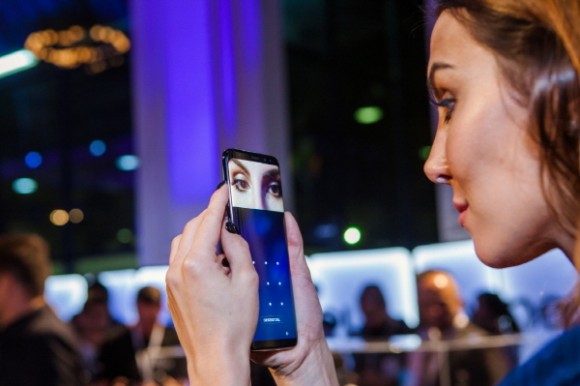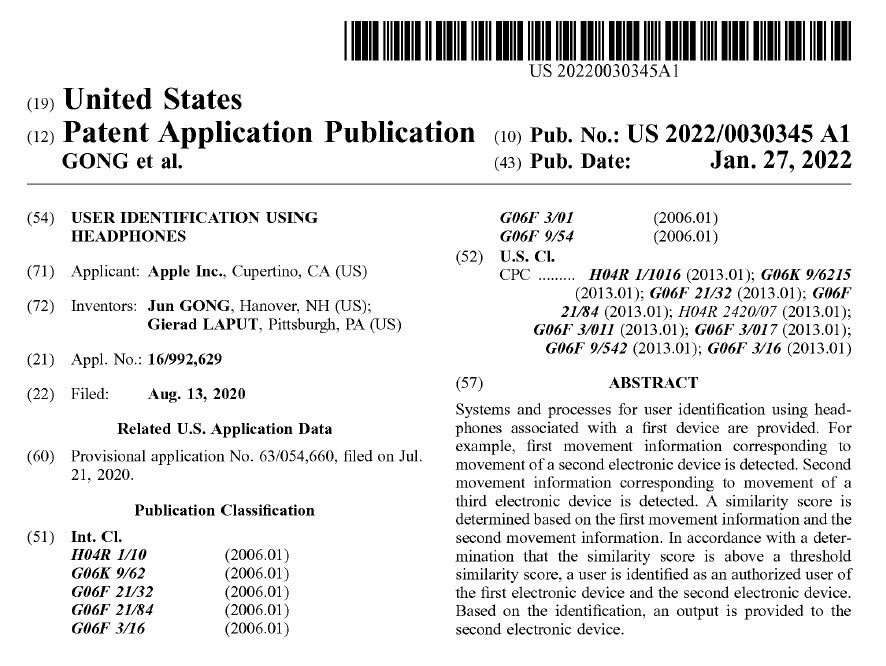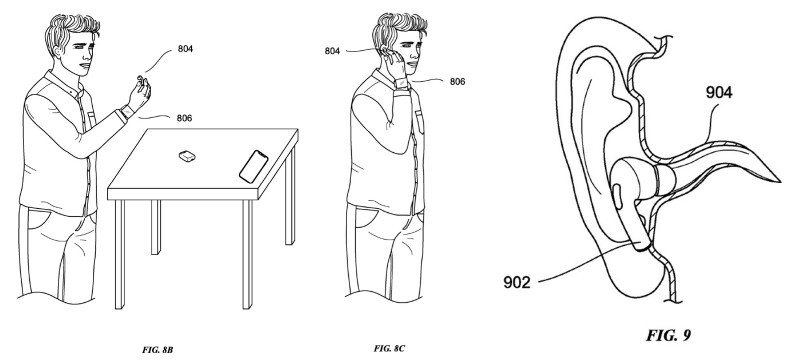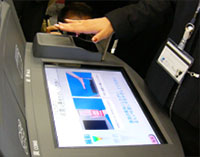Try palm vein recognition / Fujitsu "Biometrics Solution"
Eliminate the risks hidden in biometrics! What is Hitachi's security technology "PBI"? ??
LOTTE CARD: Secure shopping with no need to go shopping --Hand Pay payment system based on palm vein authentication.
If the person was killed, the arm was amputated and transplanted, and the heart was also transplanted, it would be scary like a science fiction novel.
I feel that it is safer to use earphones in the ears, emit ultrasonic waves, and log in with authentication in the form of the inside of the ears. Even if he is killed and transplanted around his ears and disguised, it looks like a science fiction novel and is scary.
If the person was killed, and the arm was amputated and transplanted, and the heart was also transplanted, the fake is scary, like a science fiction novel, if there is one.
I think it would be safer to use earphones in the ear to emit ultrasonic waves and use the shape of the inside of the ear as an authentication login. Even if the person is killed and the transplant is disguised as an ear transplant, it still sounds like something out of a sci-fi novel.
When this happens, it seems that the person himself will not be killed if it is the shape of the brain, the nerves of the brain, consciousness, telepathy, and other authentication logins.
If this happens, it seems that the brain shape, brain nerves, consciousness, telepathy, or other authentication logins would not kill the person in question.
-----------
LOTTE CARD: Secure shopping with no need to go shopping --Hand Pay payment system based on palm vein authentication.
If the person was killed, the arm was amputated and transplanted, and the heart was also transplanted, it would be scary like a science fiction novel.
I feel that it is safer to log in with earphones in the ears, ultrasonic waves, and in the form of the inside of the ears. Even if he is killed and transplanted around his ears and disguised, it looks like a science fiction novel and is scary.
If the person was killed, and the arm was amputated and transplanted, and the heart was also transplanted, the fake is scary, like a science fiction novel, if there is one.
I think it would be safer to use earphones in the ear to emit ultrasonic waves and use the shape of the inside of the ear as an authentication login. Even if the person is killed and the transplant is disguised as an ear transplant, it still sounds like something out of a sci-fi novel.
When this happens, it seems that the person himself will not be killed if it is the shape of the brain, the nerves of the brain, consciousness, telepathy, and other authentication logins.
If this happens, it seems that the brain shape, brain nerves, consciousness, telepathy, or other authentication logins would not kill the person in question.
May 28, 2017 15:18
Deceive iris recognition with printed eyes! Samsung argues that it is "unrealistic"

Samsung has issued an unusual statement that it is "unrealistic" about the release of a printout of the Galaxy S8 's iris recognition technique.
It's hard to imagine what happens in real life
Controversial is a video released by the German hacker group Chaos Computer Club (CCC). In the video, after shooting and printing out the eyes of the Galaxy S8 owner using a camera that can capture infrared rays, a contact lens is placed on the pupil part to create a pseudo curve and succeed in deceiving iris recognition brilliantly. doing.

However, Samsung responded through the Korean media The Korea Herald , saying, "It's hard to think that it will happen in real life." He admitted that he had to steal his body, and while admitting the technical drawbacks, he said that the series of scenarios was unrealistic.
Biometrics is not a versatile tool
However, a CCC spokesman said, "In some cases, it is possible to capture the iris even with high-resolution photos on the Internet," claiming that it is possible to break through the certification without using an infrared camera.
" If important data is in the smartphone or you want to make a payment, the traditional PIN code entry would be a safer approach than using biometrics," said the smartphone's biometrics technology. It also emphasizes imperfections.
Samsung Pay uses iris recognition and claims that "one of the safest ways to keep your phone locked" and "it's virtually impossible to duplicate an iris". Therefore, in response to this situation, future measures are drawing attention.
In April, it was revealed that the Galaxy S8's facial recognition can be broken through using photos, and it became a hot topic.
In addition, it has been proved that fingerprint authentication can also be broken through with photographs, and paradoxically, multi-step authentication is becoming more important with the evolution of technology .
Source: The Korea Herald
(kihachi)
[Official] --Make sure you buy and book your iPhone online!





--------
Apple filed patent application for user-authenticated earphones inside the ear--measures the shape of the hole with ultrasonic waves
Devices such as smartphones use biometric authentication technologies such as fingerprint authentication and face authentication in an attempt to improve convenience while ensuring a certain level of security. However, depending on the situation, such as using it in combination with other devices, the existing authentication method may be troublesome.
On the other hand, Apple devised a technology to authenticate users from the shape inside the ear measured by earphones. When this technology was filed with the United States Patent and Trademark Office (USPTO), it was published as " USER IDENTIFICATION USING HEADPHONES " (publication patent number "US 2022/0030345 A1") on January 27, US time . The filing date is August 13, 2020.

Published Apple patent (Source: USPTO)
This patent describes a technology that allows a second device to be worn on the ear to authenticate the user and use both devices when using the two devices in combination. The second device quantifies the shape of the inside of the ear from the reflected sound of the sound wave sent inside the ear, and confirms whether the wearing user is a legitimate user. Once determined to be the correct user, voice messages arriving on the first device can be played on the second device, or voice communication through the first device can be initiated on the second device.
Regarding the second device, any type can be used as long as it can be attached to the ear and the inside of the ear can be measured. However, from the usage and explanation of the examples, it seems that a device such as an earphone is assumed. Further, although the first device is described as a tablet in the embodiment, the patent can be applied to smartphones, PCs, and the like.

Authenticate the user with earphones and allow the use of smartphones (Source: USPTO)
The sound wave that the second device captures the characteristics inside the ear may be ultrasonic wave instead of audible sound wave. It also touches on the idea of user authentication by acquiring a voiceprint from the user's voice and measuring how to walk from acceleration.
It also mentions how features inside the ear can be registered when the first device is unlocked.
A patent is an official document for the purpose of protecting the rights of technical ideas. Even if it is registered and established, it is not always used in actual products and services. Furthermore, there are many cases in which an application is filed for the purpose of making the existence of an idea a publicly known fact, and the publication is not completed without registration.
Read all CNET Japan articles by email every morning (free)
https://japan.cnet.com/article/20074799/
Bank of Tokyo-Mitsubishi adopts palm vein authentication technology for ATM
Bank of Tokyo-Mitsubishi will adopt palm vein authentication to verify the identity of the card from October 12th. The target is users of the "Super IC Card" Tokyo Mitsubishi-VISA "", which is a cash card with the functions of electronic money and credit cards. This aims to prevent damage caused by card theft and skimming.
Fujitsu's non-contact palm vein authentication technology was adopted. The veins in the palm are all different from person to person, and take advantage of the fact that they do not change for a lifetime except for their size. The person acceptance rate that correctly recognizes the person is said to be 99.9%.
 Demonstration of palm vein authentication |
The biometric data must be registered at the bank counter. However, the data is stored in the IC chip mounted on the card, and Bank of Tokyo-Mitsubishi does not own the data. "You can avoid the risk of leaking physical information," the company said. With the current technology, it is difficult to read the data in the IC chip and forge or alter it, so it is said to be "extremely safe" (the company).
By October 12, the company will install one ATM for palm vein recognition at about 260 manned stores nationwide. In addition, we plan to install one at each of about 300 unmanned stores by the end of the year. ATMs are said to be delivered by ATM Japan after receiving OEM from Fujitsu.
Edy is also standard adoption
The super IC card "Tokyo Mitsubishi-VISA" is equipped with electronic money Edy as standard equipment. For the IC chip, Sony's "RC-S952 / 1MV J", which is a single chip of contact IC and non-contact IC, was adopted. The user area is 32K bytes, which is "the largest in the practical stage" (the company). In the future, the company says, "We will consider integrated services with various fields such as transportation, communication, and distribution." The specific content was not disclosed, but it seems that they are considering cooperation with point services and postpay that adopted FeliCa.
"Tokyo Mitsubishi-VISA" can also be used as a credit card with a revolving function issued by Bank of Tokyo-Mitsubishi. "This is the first mega bank to have a credit card with a revolving function issued by the bank itself," the company said. It will be issued under the VISA brand as a franchisee of DC Card, an affiliate of the company. The company intends to acquire users by giving preferential treatment to bank ATM usage fees and fixed deposit interest rates according to the use of the credit card function.
From October 12, we will issue a gold premium card with an annual membership fee of 10,500 yen. If you register the information on the palm vein, the maximum deposit damage compensation amount is 100 million yen. From the spring of 2005, we plan to issue a gold card with a maximum compensation amount of 10 million yen and a general card with a compensation amount of 10 million yen. The annual membership fee is undecided.
 A prototype of a mobile FeliCa compatible ATM. ATM is made by Hitachi |
The investment amount for this new service is said to be 10 to 20 billion yen, aiming for a monthly surplus in 3 years and a complete surplus in 5 years. The number of new cards issued annually is planned to be 1 million, and the company aims to achieve a revolving cashing balance of 200 to 300 billion yen by FY2007.
Bank of Tokyo-Mitsubishi is also developing an ATM compatible with FeliCa Networks' mobile FeliCa. In addition to cash cards, it can also be used as a credit card or loan card. The company is aiming to start full-scale service in the fall of 2005, and is currently in the trial stage targeting the same employee's monitors. From November, we plan to offer a pilot service to employees of cooperating companies around Otemachi.
Read all CNET Japan articles by email every morning (free)








0 コメント:
コメントを投稿